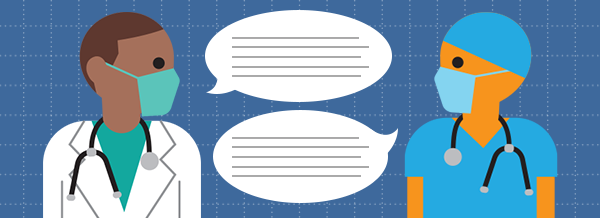Interprofessional Simulation Hones Critical Communications Skills for Nursing, Medical Students
November 18, 2021

In the midst of the ongoing COVID-19 global pandemic, Drexel University nursing and medical students joined together online for a large-scale simulation of the critical conversations physicians and nurses routinely have regarding patient care in a hospital setting.
About 250 medical students from the College of Medicine participated in the simulation, held in March 2021—shortly before graduation and the week following “match week,” when they learned where they would be doing their residencies. And more than 50 nursing students, recent alumni, faculty and nursing colleagues from the College of Nursing and Health Professions (CNHP) volunteered to attend during their break week.
Organizers overcame formidable challenges to schedule the event, which marked the first time that nursing and medical students had the opportunity to practice the kinds of conversations regarding patient care they would soon engage in on a daily basis as they begin their careers. And being able to practice those skills before graduation provides them not only with a boost in confidence, but also a competitive edge over students from other university programs that do not offer the same opportunity.
While it may have been the first time, organizers are committed to making the simulation with medical and nursing students an annual event and expanding other interprofessional simulation opportunities between the two colleges.
Sabrina Picot, BSN ’21, RN, who participated in the simulation while earning her degree through CNHP’s Nursing Accelerated Career Entry (ACE) program, graduated in September 2021 and is now a graduate nurse in the nurse residency program at Houston Methodist Hospital in Texas.
Asked how often she uses the skills that she was able to practice in the simulation, Picot replies: “Oh, every day. Because if you’re coming on day shift, you’re getting a report from the night shift nurse and you're going back and forth discussing things. And then they do rounds several times a day with the physicians and the other providers on the floor, so they're asking for updates on your patient and you're relaying information to them, like if there's a change in patient condition. So I'm always using those skills.”
Karyn Barrett, MD ’21, graduated shortly after the simulation, and is now a resident physician at Brigham and Women’s Hospital in Boston. Her experience having conversations about patient care with nursing students in the simulation helped to better prepare her for what she does every day in residency.
“When I've been rotating inpatient on the wards, it has been an everyday occurrence multiple times a day, especially when I'm dealing with acute sick patients, and there's constant vital sign changes and changes in their status and changes in their plan in terms of medication,” Barrett says. “We're communicating constantly here with nurses. So it was great that we had a practice run with that to go over what it might be like.”
‘It’s All About Patient Safety’
 Trying to safely schedule the simulation in the midst of a global pandemic greatly increased the degree of difficulty. But the benefits of making it work far outweighed any impediments. In addition to providing nursing and medical students a safe space to practice their communications skills, and the confidence boost that comes with that, the interprofessional simulation offers another, even more compelling, benefit, says Meaghan Shattuck, MSN, a CNHP assistant clinical professor.
Trying to safely schedule the simulation in the midst of a global pandemic greatly increased the degree of difficulty. But the benefits of making it work far outweighed any impediments. In addition to providing nursing and medical students a safe space to practice their communications skills, and the confidence boost that comes with that, the interprofessional simulation offers another, even more compelling, benefit, says Meaghan Shattuck, MSN, a CNHP assistant clinical professor.
“It’s all about patient safety,” Shattuck says. “That is why it is so important for both future nurses and future physicians to live this type of communication because it really is about the patient and the safety and the quality of the care that we need to give to our patients.”
 The simulation grew out of discussions about interprofessional collaborations between Dana C. Farabaugh, MD, associate dean for clinical education in the College of Medicine and professor in the Department of Obstetrics & Gynecology, and Kate Morse, PHD, assistant dean for experiential learning and innovation, and associate clinical professor in CNHP.
The simulation grew out of discussions about interprofessional collaborations between Dana C. Farabaugh, MD, associate dean for clinical education in the College of Medicine and professor in the Department of Obstetrics & Gynecology, and Kate Morse, PHD, assistant dean for experiential learning and innovation, and associate clinical professor in CNHP.
Determined to provide graduating medical and nursing students the chance to practice patient care conversations in a realistic simulation before they began their careers, Morse and Farabaugh enlisted Shattuck and Genevieve M. Porrecca, MSN, an assistant clinical professor and simulation education specialist, to help plan and recruit students, as well as faculty and alumni, to participate.
When doctors and nurses communicate with each other and with other members of the care team about a patient’s condition, it is crucial to focus on the information they need to know in the moment to make the best decisions regarding care. CNHP teaches nursing students a communications framework known as SBAR, which stands for Situation-Background-Assessment-Recommendation.
“It creates a structure so that you're talking in a way that's predictable, which makes it easier for the person who's listening,” Morse says.
The simulation gave the nursing students a chance to use the SBAR framework in conversations with medical students for the first time, and it gave medical students the opportunity to engage with nursing students who bring a different and valuable perspective and training to care teams. The experience, which they would soon encounter in the real world, helped both feel better prepared.
“The cases that we created were ones that we took from our own experiences, where we knew communication could easily fail if people didn't necessarily put forth what they really thought was happening or push back if they weren't getting the response that they were looking for,” Farabaugh says. “So we wanted them to be scenarios that challenged the students to really own what they were thinking and their opinion and be able to communicate that to the other partner, to engage in a more meaningful conversation that was going to ultimately benefit the patient.”
‘Nursing Is Not an Individual Sport’
The care teams for the simulation usually consisted of two medical students and one nurse. One scenario had the medical student initiate a call to a nurse at bedside to discuss whether a change in results from lab work and radiology merited transferring the patient to a higher level of care. Another had the nursing student initiate a call to the physician regarding a change in the patient’s vital signs. The third scenario started with family members expressing a concern about a patient’s pain management to the nurse, and the nurse then calling the doctor.
One of the most important takeaways for students was the feedback they got from fellow students, faculty and alumni following the simulations.
 “I like to say to the students, nursing is not an individual sport. You have a whole team around you of people who do different things and you need to rely on that whole team in order to care for your patient,” Porrecca says.
“I like to say to the students, nursing is not an individual sport. You have a whole team around you of people who do different things and you need to rely on that whole team in order to care for your patient,” Porrecca says.
“They have social workers and dietitians and different physicians, specialties and nurse practitioners and physician assistants. They know that they have this team to rely on and go to with questions or concerns. And the more we bring it to them, the earlier in their careers and in their educational journey, the easier it's going to be for them to use this team when they get out into practice.”
‘Clear, Direct Communication’
Students and alumni who participated agree that the simulation was a valuable learning experience that carries over in the work they’re doing today.
Jill Hulbert, BSN ’18, now works in Bryn Mawr Hospital’s intensive care unit on Philadelphia’s Main Line. She participated in the simulation as an alumna who has been working professionally as a nurse for three years.
“I would have really appreciated that as a student,” Hulbert says. “I feel like doing more simulations like that would be very helpful for both the medical students and for the nursing students. I would say it’s pretty accurate. Doctors depend on our clear, direct communication of what's going on to make decisions and trust us to carry those out, which is really important.”
Sarah Madden, BSN ’21, says the simulation “gave me a lot more confidence … and to know that we all have something to teach each other. I thought it was a great experience.”
The new Drexel University Health Sciences Building, slated to open in 2022, will bring together the College of Nursing and Health Professions and College of Medicine in a state-of-the-art, 450,000-square-foot building at 36th and Filbert streets, enhancing interprofessional and interdisciplinary collaboration, research and practice opportunities. CNHP is scheduled to move into the building in 2022, with College of Medicine moving in 2023. Being together under one roof will allow easier collaborations and planning for interprofessional events.
“From my perspective, I think what I learned most from this simulation is the more real it can be, the better,” Morse says. “I think it'll be great to just be in the shared space where people will run into each other and start chatting and find common interests and start to build on those. I think our new space will allow us to create these scenarios that are embedded in real life.”